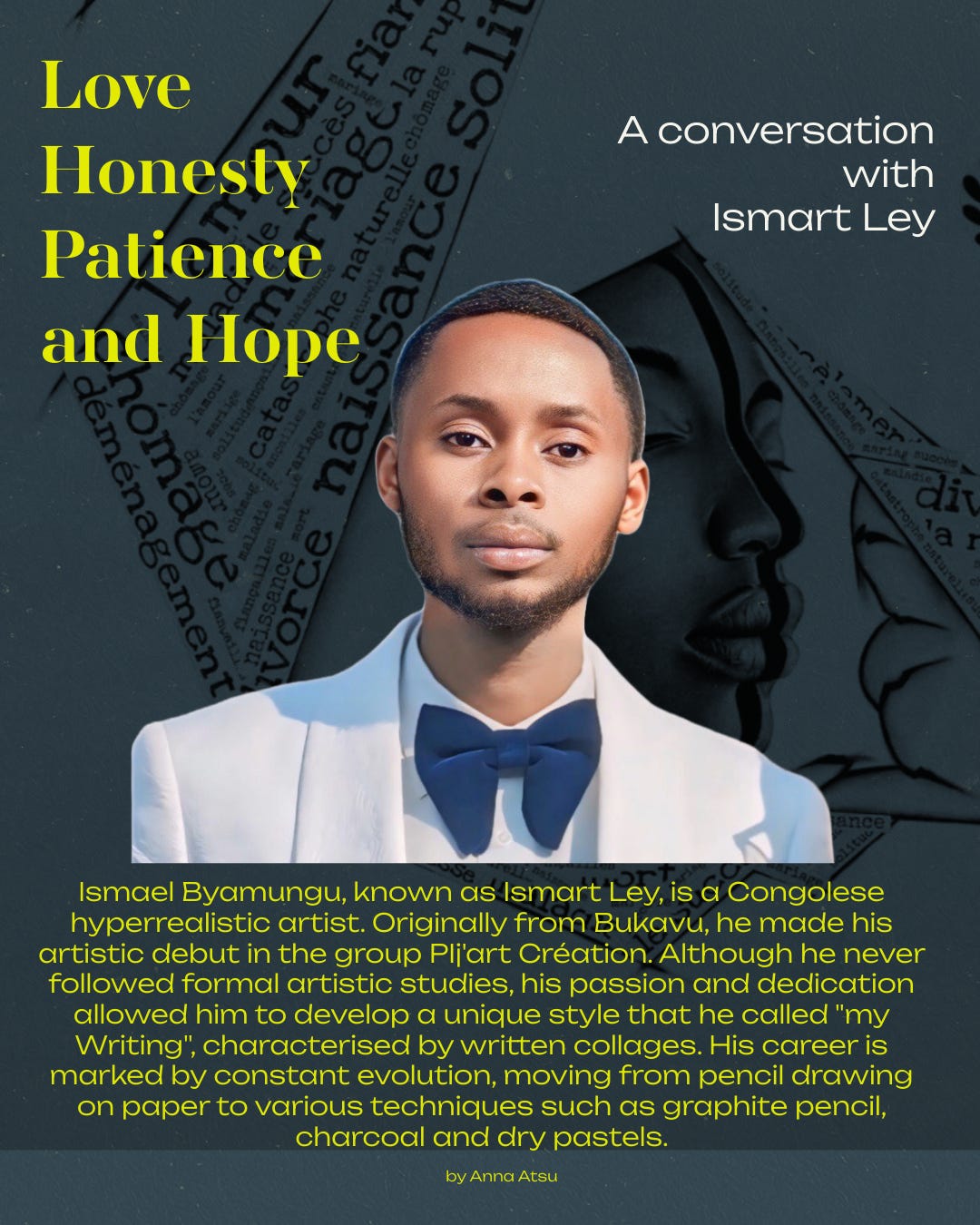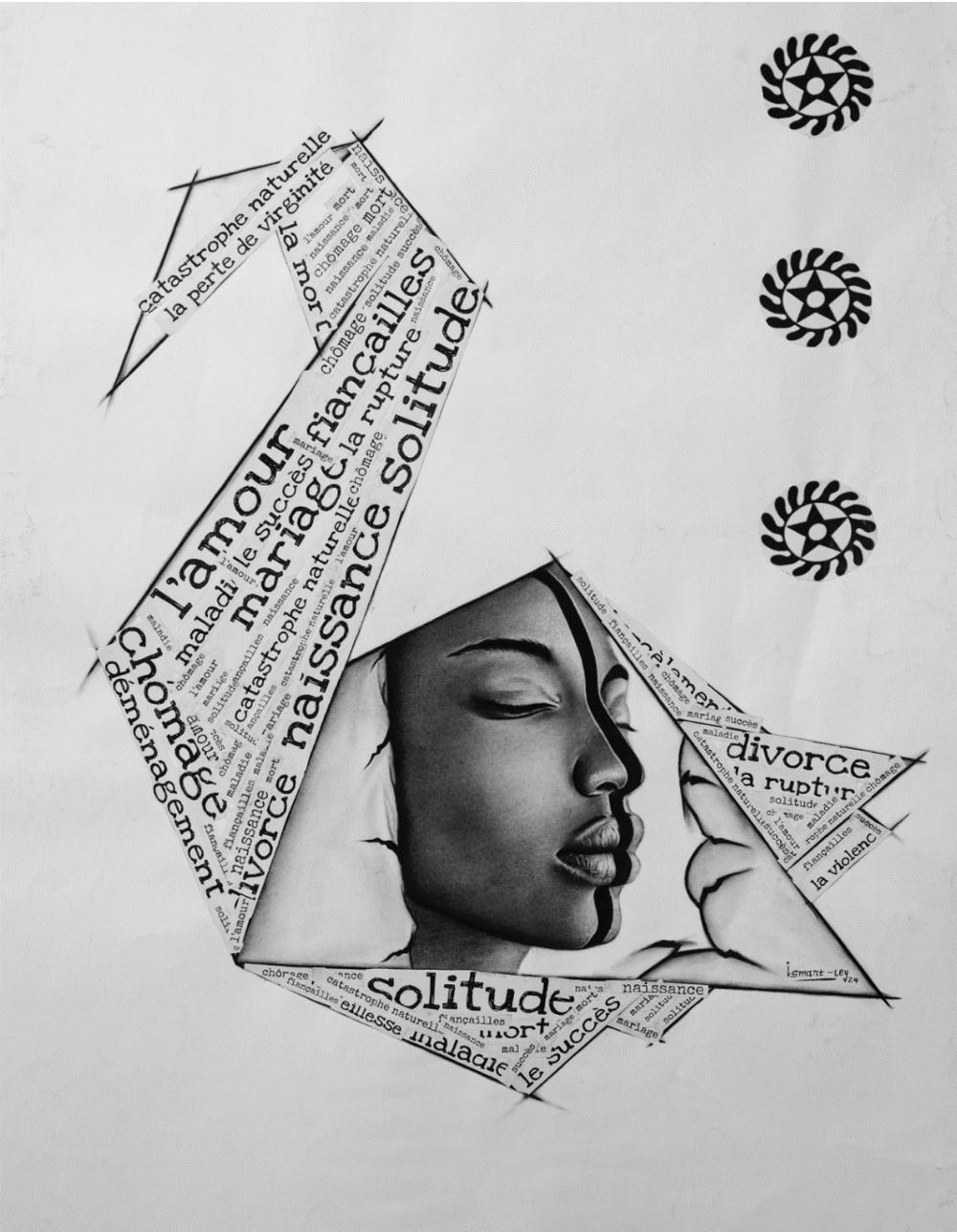Ismael Byamungu, known as Ismart Ley, is a Congolese hyperrealistic artist. Originally from Bukavu, he made his artistic debut in the group PIj’art Création. Although he never pursued formal artistic studies, his passion and dedication allowed him to develop a unique style that he called “my Writing,” characterised by written collages. His career is marked by constant evolution, from pencil drawing on paper to various techniques such as graphite pencil, charcoal, and dry pastels.
Please, tell us about yourself.
I was born in Bukavu, in the eastern part of the Democratic Republic of Congo, into a modest family facing many financial hardships. Growing up in that environment wasn’t easy, but over time, I learned to see that reality as a source of strength. It’s what pushed me to dedicate myself to art — not only out of passion, but also with the hope of one day being able to support my family.
Since childhood, I’ve always been very reserved, and I live with a stutter, which makes verbal communication difficult for me. It’s a pain I carry, but it also gave me something precious: the need to express myself differently. And it’s through art that I found that voice. Drawing became my language, my way of opening my heart to the world — sincerely and without fear.
I never had the opportunity to study art formally, but my passion and determination have allowed me to grow. Over time, I developed a style I call “my handwriting” — a combination of hyperrealistic charcoal drawings and handwritten collage. It’s my personal language, a deep way of conveying what I feel.
I wouldn’t have come this far without Phinefor Dry and John Mombo, my two soul brothers with whom I co-founded PIJ’art Création. We supported, inspired, and carried each other. I’ll also never forget Kefa Migani and Mardochée Migani, who have been constant sources of encouragement throughout my journey.
Even though I studied something else at school, I left several jobs to stay true to my path as an artist. I’m not yet reaping the rewards of everything I’ve sown, but I have faith that one morning, everything will change. Until then, I continue to create — with love, patience, and hope.
Your work often carries a deep symbolic message. Can you share a metaphor that reflects how you see life?
For me, origami is more than just the art of folding paper — it’s a powerful metaphor. I see our daily life as an origami sheet, constantly being folded by unexpected events, whether joyful or painful. Birth, death, marriage, illness, war, natural disasters — these are just some of the creases that shape us.
We only get one life, but it can be folded a thousand ways. Still, most people feel secure in routine, and when change — good or bad — interrupts that rhythm, it unsettles them. They lose their bearings.
We need to accept reality instead of letting negative thoughts overwhelm us.
Imagine the future instead of dwelling on the past — because driving while staring in the rear-view mirror leads nowhere. Focus on the positive, do good around you, cultivate a mindset of resilience and adaptability, and choose your friends wisely.
If we get stuck in the past or worry too much about the future, we can lose sight of what we want to do now.
Your style is very personal. Can you tell us about a particular complex piece or healing to create?
It was a piece called SULUISHO YA MATESO. It was emotionally intense and technically complex, as I combined many symbolic elements into a single composition. It deeply affected me, both artistically and personally. What moved me most was the challenge of conveying a message linked to the Bible as a religious book and a source of identity, memory, and hope. This work required time, reflection, and courage, as I felt a great responsibility in how I had to represent it.
What role does memory play in your creative process?
Memory is the common thread running through my work. Each drawing, each collage, is an attempt to capture fragments of memories, whether personal or collective. By exploring these reminiscences, I seek to understand how the past shapes our identity and our perception of the world.
What does a typical day in your studio look like? Do you have any rituals before you start working?
My day begins with a moment of silence, a cup of tea in hand, to centre myself. Before touching my tools, I listen to soft music, instrumental music: jazz, or traditional African sounds. These melodies help me focus and enter a meditative state conducive to creation. These rituals allow me to connect with intuition and let my imagination run wild.
You’ve mentioned honesty and hope. Are there moments when you doubt your path? What helps you stay grounded?
Keep reading with a 7-day free trial
Subscribe to TODAY'S to keep reading this post and get 7 days of free access to the full post archives.



